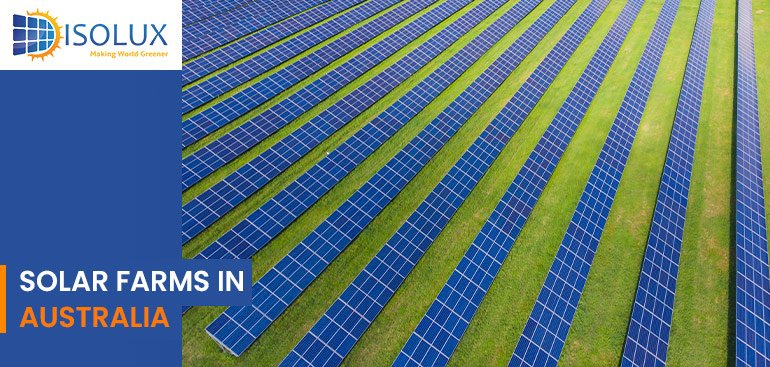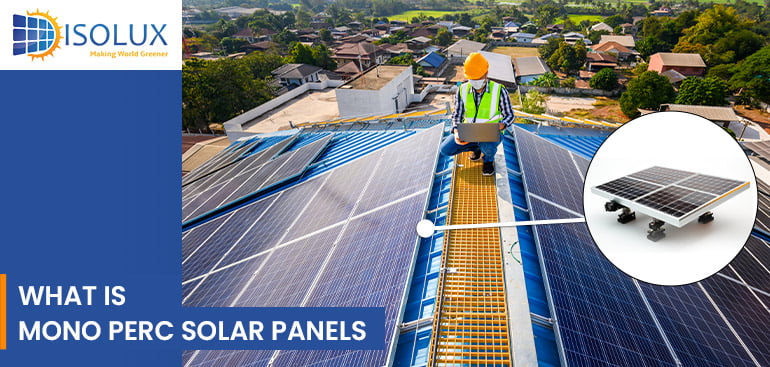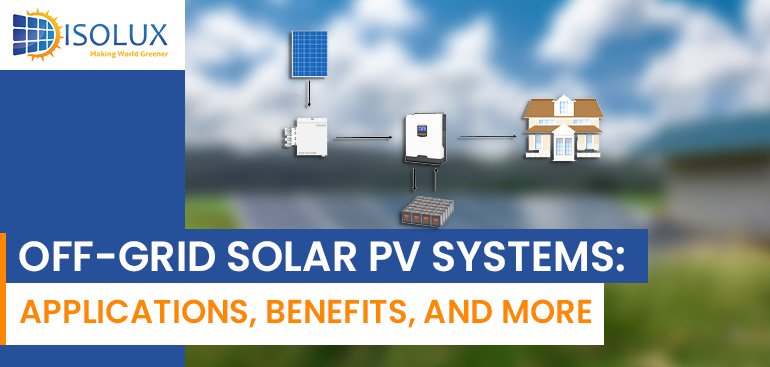Australia’s vast landscapes and abundant sunshine make it an ideal location for solar farms, a key player in the nation’s journey towards renewable energy. As climate change concerns mount and the global community shifts towards sustainable energy solutions, solar farms are becoming increasingly crucial. This blog explores the concept of solar farms, their workings, costs, and power production capabilities, spotlighting Australia’s largest solar farms.
What is a Solar Farm?
A solar farm, also known as a photovoltaic power station, is a large-scale solar photovoltaic (PV) system designed for the supply of merchant power to the electricity grid. They are significantly larger than residential or commercial solar setups, spreading over acres of land. These farms harness sunlight, converting it into electricity through thousands of solar panels systematically arranged across a field or desert area.
How Does a Solar Farm Work?
Solar farms operate on the principle of converting sunlight into electricity using photovoltaic panels. These panels contain solar cells made from layers of silicon or other materials that create an electrical field. When sunlight hits the panels, it excites the electrons in the solar cells, creating direct current (DC) electricity. Inverters then convert this DC electricity into alternating current (AC), which is compatible with the electricity grid and can be used to power homes, businesses, and industries.
How Much Does a Solar Farm Cost?
The cost of building a solar farm in Australia varies widely based on the project’s scale, location, and technology used. On average, the construction of a solar farm can range from $1 million to $1.5 million per megawatt (MW) of installed capacity. Factors affecting the cost include land acquisition, solar panels, inverters, labor, and grid connection infrastructure. Despite the significant initial investment, solar farms offer low operating costs and a sustainable energy source, potentially providing returns over the long term.
how Much Power Does a Solar Farm Produce?
The power production of a solar farm depends on its size, the efficiency of the solar panels used, and the amount of sunlight the location receives. Generally, a 1 MW solar farm can generate approximately 1,400 to 1,600 megawatt-hours (MWh) of electricity annually in Australia, enough to supply around 200 average Australian homes. Larger farms, with capacities of 100 MW or more, can power tens of thousands of homes and significantly contribute to reducing carbon emissions.
Largest Solar Farms in Australia
Australia is home to some of the world’s most significant solar projects, reflecting the country’s commitment to renewable energy:
1. New England Solar Farm
This ambitious project is poised to become one of the largest solar farms in Australia. It underscores New South Wales’ commitment to renewable energy and, upon completion, will significantly contribute to the state’s energy needs, powering hundreds of thousands of homes.
Location: Uralla, New South Wales
Total Capacity: Up to 720 MW upon completion
2. Western Downs Solar Farm
Set to be one of Australia’s largest solar projects, the Western Downs Solar Farm is designed to provide a significant boost to Queensland’s renewable energy production. Its capacity is enough to supply power to around 235,000 Australian homes, showcasing the potential of solar energy in large-scale applications.
Location: Western Downs Region, Queensland
Total Capacity: 400 MW
3. Limondale Solar Farm
As one of the largest operational solar farms in Australia, Limondale makes a considerable contribution to the renewable energy sector. It highlights the scalability of solar technology and its pivotal role in providing sustainable energy solutions.
Location: Near Balranald, New South Wales
Total Capacity: 349 MW
4. Darlington Point Solar Farm
This significant solar project contributes substantially to New South Wales’ renewable energy supply. With its substantial capacity, it’s capable of powering over 115,000 homes annually. The farm plays a crucial role in Australia’s efforts to transition to cleaner energy sources.
Location: Darlington Point, New South Wales
Total Capacity: 275 MW
5. Aldoga Solar Farm
Aldoga Solar Farm is set to contribute significantly to Queensland’s renewable energy goals. Located near Gladstone, a hub for energy production, this project aligns with regional strategies for clean energy development and environmental sustainability.
Location: Gladstone, Queensland
Total Capacity: Approximately 250 MW
6. Bungala Solar Farm
Bungala Solar Farm adds a significant renewable energy source to South Australia’s grid. This project is part of the region’s transition towards sustainable energy sources, leveraging the state’s favorable solar conditions.
Location: Near Port Augusta, South Australia
Total Capacity: 220 MW
7. Woolooga Solar Farm
Woolooga Solar Farm is part of Queensland’s broader initiative to harness solar energy across the state. Though details on its size are scarce, its development contributes to the regional goal of increasing renewable energy sources.
Location: Woolooga, Queensland
Total Capacity: 176 MW
8. Kingaroy Solar Farm
Kingaroy Solar Farm in Queensland, though smaller than some of its counterparts, represents the diversification of solar energy projects across the country.
Location: Kingaroy, Queensland
Total Capacity: 50 MW
How to Start a Solar Farm in Australia
Starting a solar farm in Australia involves a series of strategic, regulatory, and financial steps. The process is comprehensive, requiring careful planning and execution.
1. Conduct Feasibility Study
Assess Location: Consider factors like solar irradiance, land availability, and proximity to the grid.
Preliminary Financial Analysis: Estimate costs, potential revenues, and return on investment.
Environmental Impact: Evaluate the potential environmental impact and any ecological considerations.
2. Secure Land
Lease or Purchase: Decide whether to lease or purchase land based on the feasibility study.
Land Agreement: Negotiate terms and conditions for the land use, ensuring it meets the size requirements for your intended capacity.
3. Obtain Permits and Approvals
Local Government: Apply for planning permits from the local council or government authority.
Environmental Approvals: Ensure compliance with environmental regulations and obtain necessary approvals.
Grid Connection: Secure an agreement with the local grid operator for connection and energy distribution.
4. Design and Engineering
Select Technology: Choose the type and model of solar panels and inverters.
System Design: Plan the layout of the solar farm, including panel arrangement, electrical infrastructure, and access roads.
Engineering Assessment: Perform detailed engineering assessments to finalize the design.
5. Secure Financing
Capital Requirements: Determine the total capital requirement, including equipment, construction, and operational costs.
Funding Sources: Explore funding options such as loans, grants, investors, or government incentives for renewable energy projects.
6. Procurement and Construction
Equipment Procurement: Procure solar panels, inverters, mounting systems, and other necessary equipment.
Contractor Selection: Hire experienced contractors for construction and installation.
Construction: Oversee the construction process, ensuring compliance with design specifications and safety standards.
7. Connect to the Grid and Launch
Grid Connection: Complete the connection to the local electricity grid as per the agreement.
Commissioning: Perform testing and commissioning to ensure the solar farm operates efficiently.
Operation: Begin operation, monitoring, and maintenance of the solar farm.
8. Maintenance and Operations
Regular Maintenance: Implement a maintenance schedule to ensure optimal performance.
Monitoring System: Use monitoring systems to track performance and identify any issues promptly.
9. Regulatory Compliance and Reporting
Compliance: Ensure ongoing compliance with local, state, and federal regulations.
Reporting: Submit regular reports as required to regulatory bodies and stakeholders.
Additional Considerations
Community Engagement: Engage with the local community to address any concerns and ensure support for the project.
Insurance: Obtain appropriate insurance coverage for the solar farm.
Market Research: Stay informed about the energy market, regulations, and technological advancements.
Starting a solar farm is a complex and capital-intensive process. It requires thorough planning, a deep understanding of the regulatory environment, and effective project management. Potential developers should consider consulting with industry experts, including legal advisors, environmental consultants, and financial analysts, to navigate the process successfully.
Conclusion
Australia’s investment in solar farms is a testament to the nation’s commitment to renewable energy and sustainable practices. These large-scale solar installations not only reduce carbon emissions but also create jobs, stimulate economic growth, and provide a reliable, clean energy source for decades. As technology advances and costs continue to decrease, solar farms will play an increasingly vital role in Australia’s energy landscape, shining a light on a cleaner, greener future.
Contact Isolux Solar for commercial solar panel installation in Sydney, Australia. Get a free quote now!
Also read:
How Solar Panels are Installed in Australia?
FAQs
A typical solar farm can produce between 1 to 2 megawatt-hours (MWh) per acre per year. For instance, a 100 MW solar farm might cover around 200 to 500 acres and can generate enough electricity to power approximately 20,000 to 40,000 average homes annually.
The number of solar panels in a solar farm can range from a few thousand to over a million, depending on the farm’s capacity. For a rough estimate, a 1 MW solar farm typically requires about 3,000 to 4,000 solar panels. Therefore, a larger farm with a capacity of 100 MW could have between 300,000 to 400,000 solar panels.
The time to build a solar farm can vary from a few months to over a year, depending on the project’s size, complexity, and various regulatory and construction processes. Smaller solar farms (1-20 MW) might be completed in 6 to 12 months, while larger projects (over 100 MW) could take 1 to 2 years from planning to operational status.
The largest solar farm in Australia is Sun Cable’s Australia-Asia PowerLink project in the Northern Territory, which, when completed, is expected to be one of the world’s largest solar farms. However, among operational farms, the Western Downs Solar Farm in New South Wales is one of the largest, with a capacity of over 400 MW.




